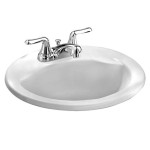How To Replace A Washer In Bathroom Sink Tap
A dripping bathroom sink tap is a common household nuisance. It is not only irritating but also wastes water, potentially leading to higher water bills and environmental concerns. Often, the culprit behind this drip is a worn-out washer inside the tap. Replacing the washer is a relatively simple and cost-effective DIY project that most homeowners can accomplish with basic plumbing knowledge and a few common tools. This article provides a comprehensive guide on how to replace a washer in a bathroom sink tap.
Before commencing any plumbing repair, safety is paramount. Water can conduct electricity, and working without taking proper precautions can be hazardous. Therefore, the first step is always to shut off the water supply to the tap. This is typically achieved by locating the shut-off valves beneath the sink. There are usually two valves, one for hot water and one for cold water. Turn both valves clockwise until they are completely closed. After closing the valves, turn on the tap to relieve any remaining pressure in the pipes. If no water flows, the water supply is successfully shut off. If water continues to flow, the shut-off valves may be faulty and need replacement themselves. In such cases, it may be necessary to shut off the main water supply to the entire house, usually located near the water meter.
Once the water supply is safely shut off, gather the necessary tools and materials. A few essential tools for this project include an adjustable wrench, a flathead screwdriver, a Phillips head screwdriver, a pair of pliers, a utility knife, and a new washer that matches the size and type of the old one. A small container or towel to catch any residual water is also recommended. Having these tools readily available will ensure a smooth and efficient repair process. It is always advisable to have a variety of washers on hand, as tap designs can vary, and the exact size needed may not be immediately apparent until the old washer is removed.
Identifying the Type of Tap
Bathroom sink taps come in various designs, but the most common types are compression taps, cartridge taps, and ball taps. The method for replacing the washer varies slightly depending on the tap type. A compression tap relies on a rubber washer being compressed against a valve seat to stop the flow of water. These are the most common type and the focus of this guide. Cartridge taps use a cartridge to control water flow and temperature. Ball taps, less common in bathrooms, use a ball valve mechanism. Identifying the tap type is crucial before proceeding, as it influences the disassembly process.
This guide focuses on compression taps, identifiable by their traditional design where separate handles control hot and cold water. If a single handle controls both temperature and flow, it is likely a cartridge or ball tap. For cartridge or ball taps, the washer replacement process is significantly different and may involve replacing the entire cartridge or ball valve assembly.
Disassembling the Tap
The disassembly process begins by carefully removing the decorative tap handle. This usually involves either unscrewing a setscrew located on the side or underneath the handle, or by prying off a decorative cap on top of the handle to reveal a screw. Use a small flathead screwdriver to gently pry off the cap, if present. Once the screw is exposed, use a Phillips head screwdriver to remove it. After removing the screw, the handle should pull off easily. Avoid forcing the handle, as this could damage it or the tap body.
With the handle removed, the valve stem is now accessible. The valve stem is the central component that controls the water flow. Using an adjustable wrench, carefully loosen and unscrew the packing nut that holds the valve stem in place. Be cautious not to overtighten the wrench, as this can damage the nut or surrounding components. As you loosen the nut, some water may seep out, so be prepared with a container or towel to catch it. Once the packing nut is removed, gently pull the valve stem out of the tap body. This may require a slight rocking motion to loosen it.
With the valve stem removed, the old washer will be visible at the bottom of the stem. Examine the washer closely. It may be worn, cracked, or disintegrated. Use a small flathead screwdriver or a utility knife to carefully remove the old washer. Note how the washer is attached to the stem. In most cases, it is held in place by a small screw or a nut. If a screw is present, unscrew it to release the washer. If a nut is present, use a small wrench or pliers to loosen and remove the nut. Retain the screw or nut, as it will be needed to install the new washer.
Installing the New Washer
Select a new washer that matches the size and type of the old one. Using the wrong size or type of washer can result in leaks or prevent the tap from shutting off properly. Place the new washer onto the valve stem, ensuring it is seated correctly. Secure it in place using the same screw or nut that held the old washer. Tighten the screw or nut snugly, but avoid overtightening, as this can damage the washer or the stem. Once the new washer is securely in place, inspect it to ensure it is properly aligned and not pinched or twisted.
Before reassembling the tap, inspect the valve seat inside the tap body. The valve seat is the surface against which the washer presses to stop the water flow. Over time, the valve seat can become corroded or damaged, preventing a proper seal. If the valve seat appears worn or damaged, it may need to be reamed or replaced. Valve seat reamers are specialized tools designed to smooth and flatten the valve seat surface. Follow the manufacturer's instructions for using a valve seat reamer. If the damage is too severe, the entire tap may need to be replaced.
After inspecting and, if necessary, repairing the valve seat, reassemble the tap. Gently insert the valve stem back into the tap body, ensuring it is properly aligned. Hand-tighten the packing nut, then use the adjustable wrench to tighten it further, but avoid overtightening. The packing nut should be snug enough to prevent leaks, but not so tight that it restricts the movement of the valve stem. Replace the decorative tap handle, securing it with the screw or setscrew. Ensure the handle is properly aligned and tight.
Testing and Troubleshooting
Once the tap is reassembled, slowly turn the water supply back on at the shut-off valves beneath the sink. Open the tap to allow water to flow, and then close it. Check for any leaks around the tap body, the packing nut, and the base of the handle. If leaks are present, tighten the packing nut slightly. If the leaks persist, the packing nut may need to be replaced, or the valve seat may require further attention. If the tap still drips after replacing the washer, the problem may lie elsewhere, such as a damaged valve seat or a faulty tap body. In such cases, it may be necessary to consult a professional plumber.
After confirming that there are no leaks, observe the water flow and temperature. Ensure that both hot and cold water flow properly and that the water temperature is as expected. If the water flow is restricted or the temperature is incorrect, the problem may be related to the water supply lines or the mixing valve within the tap. These issues may require further investigation and repair.
Finally, clean up the work area. Remove any tools, materials, and debris. Wipe up any spilled water. Properly dispose of the old washer and any other waste materials. With the tap repaired and the work area cleaned, the project is complete. Replacing a washer in a bathroom sink tap is a straightforward DIY project that can save water, reduce water bills, and eliminate the annoying sound of a dripping tap. By following these steps and taking the necessary precautions, most homeowners can successfully complete this repair with minimal effort and expense.

How To Change A Washer On Mixer Tap Living By Homeserve

Learn The 7 Diy Steps To Replace Your Tap Washer Blog

How To Change Bathroom Taps Everything You Need Know

Leaking Tap Learn How To Change A Washer

Your Guide To Replacing Tap Washers Qs Supplies

How To Change A Tap Washer Warehouse

How To Easily Replace Basin Taps Step By

How To Replace A Tap Washer In 10 Easy Steps Hpg Solutions

How To Change A Tap Washer

How To Change A Washer On Mixer Tap Bathroom Ideas
Related Posts







